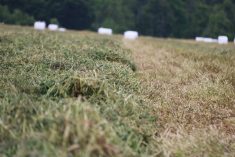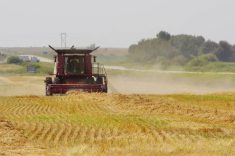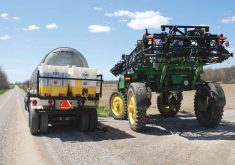Glacier FarmMedia – A plot of white beans at Agriculture and Agri-food Canada’s (AAFC) Harrow, Ont. research farm is part of a new four-site study taking a sandblasting-style approach to weed control in Canadian crops.
“No, it’s not a joke,” begins a news release from the federal agriculture ministry about the research into what’s being called “abrasive or projectile weed control.” Following up on work conducted over the past few years at a university in Nebraska, “it’s a real concept that aims to tackle a serious and costly problem for farmers and their crops – herbicide resistance in weeds.”
Why it matters: If the method proves economical, it could benefit producers of both conventional and organic row crops and horticulture crops.
Read Also

How much nitrogen can farmers really cut?
Manitoba fertilizer trials look for nitrification inhibitor sweet spot, to lower greenhouse gas emissions and cost without hurting yield.
Dr. Robert Nurse is heading Harrow’s participation in the two-year project – which, the AAFC research scientist noted in a recent interview, could be extended if the researchers across the country determine it’s worthwhile pursuing additional funding to continue their trials.
Nurse said the Nebraska work has tackled various crops, with silage corn getting the main focus. Canadian researchers decided to hone in on high-value crops, with other plots across the country using commercially-available sandblasting grit aimed at weeds in potatoes, vineyards and blueberries.
Things got underway with this year’s planting of white beans, and Nurse’s team decided to target broadleaf weeds only: lamb’s quarters, pigweed, nightshades, lady’s thumb and ragweed.
“We didn’t want to get too focused on broadleaf versus grasses at this point in the research,” he said.
They also aimed to “keep things simple” by mimicking the in-field activities that typically unfold over the season for either a conventional herbicide program or an organic program of between-row cultivation.
“We want to find that sweet spot,” Nurse said, where a recommendation can be formulated for when to make a “sandblasting pass” similar to what you might read on a label for when to apply herbicide, or read in an organic handbook about when to scuffle the weeds.

Across Canada, researchers are exploring a range of grit sizes and grit materials from a list of commercially available options – which run the gamut from plastic pellets to steel shot to crushed corn cobs to glass beads to baking soda. For the weeds in the beans at Harrow, walnut shells and cornmeal were the chosen projectiles.
“We want to target the really small weeds,” he reported – for most species, between five and 10 centimetres. Optimally, the aim is to “fry and kill the growing point of those weeds.”
But in weeds where it’s impractical due to crop pass timing or weed physiology to target the growing point, the aim is to destroy enough of the biomass that the unwanted species becomes more susceptible to diseases or insects, or simply less able to compete with the crop for resources.
At a Quebec site, a sandblasting unit was rigged up to the side of a tractor. In Harrow, they strapped the air compressor to a gator and someone rode along with the nozzle pointed at the weeds at the base of the crop in the row. Nurse says this method was effective from a research perspective because they could maintain a constant speed, track how much grit they were using, and accurately calculate the output from the nozzle over a distance.
After an initial pass, they went back in two weeks and hit the weeds with pressurized projectiles a second time.
So, after one season of research, could projectile weeding in white beans be labelled a success? Not yet, Nurse says. That’s because sandblasting nozzles aren’t designed to simultaneously target a 30 to 50-centimetre swath with a stream of grit – in the way that a pass of applied herbicide or scuffling might tackle the space between the rows of a row-cropped field.
“Effectiveness – that’s something we’re going to have to work on,” he said. “We’re probably going to have to design our own spray nozzle.” And because there’s typically a loss of pressure when modifications widen the spray pattern, this could present a challenge. That pressure is necessary, Nurse notes, for the projectile approach to be effective.
Going forward, the team will also look at spraying grit with a commercially-available nozzle followed by a reduced herbicide program to control the between-row weeds. Or, with organics, some between-row tillage.
“I think it has potential,” the lead researcher said, adding that even introducing “a different selection pressure on the weeds” counts as a positive outcome. “But unless we can get better pressure with spray widths widened out, it’s not going to be a standalone method.”
The AAFC news release noted that “the air-propelled abrasives being tested would not require registration by Canada’s Pest Management Regulatory Agency, (meaning) projectile materials could be made available to farmers after only two years of small plot testing.”
– This article was originally published at Farmtario.














